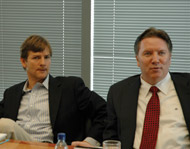|
COVER STORY, OCTOBER 2007
Southern Strength & Stability
Annual roundtable discussion by industry experts shows why the Southeast continues to be one of the strongest and consistently growing retail markets in the country.
Roundtable chaired by Scott France, Randall Shearin, Chris Thorn and Daniel Beaird
 |
SCB’s Atlanta roundtable highlighted many developing areas in the Southeast.
|
|
Recently Shopping Center Business and Southeast Real Estate Business hosted their annual Southeast Retail Roundtable at the offices of Arnall Golden Gregory (AGG) at Atlantic Station in Midtown Atlanta. Many thanks to AGG for hosting us once again. The list of attendees at the 2007 Southeast Retail Roundtable included: Brandon Ashkouti, Ashkouti Realty Corp.; Charley Carter, Weingarten Realty; Ruth Coan, Shopping Center Group; Mike Cohn, Faison; Chris Decoufle, CBRE; Michele Del Monaco, Mimms Enterprises; Hazel Dennis, Fickling; Jeff Fuqua, Sembler; Jeff Garrison, North American Properties; Jack Halpern, Halpern Enterprises; Whitney Knoll, Staubach; John Leonard, Marcus & Millichap; Richard Levine, BridgePointe Advisors; David McClinton, McClinton & Co.; Joe Montgomery, Colliers Spectrum Cauble; Ron Pfohl, Forum Development Group; Kevin Polston, Cousins; Bill Read, Developers Diversified Realty; Gary Saykaly, BridgePointe Advisors; Abe Schear, Arnall Golden Gregory; Harold Shumacher, The Shumacher Group; and Liz Whiteside, Staubach.
SREB: What is the investment climate like in the Atlanta area currently?
John Leonard: It is very strong. There is capital in the marketplace from Florida and California. It is an extremely active market. The lending side is tight now but it will work itself out. There is still plenty of capital in the Southeast.
 |
Whitney Knoll and Mike Cohn.
|
|
Whitney Knoll: I see the market as strong for Class A properties. The debt markets have a lot of people scared. When people go out to get quotes, six of seven lenders won’t even quote right now. That will settle down. We still have strong interest in the Southeast from all different types of investors.
Gary Saykaly: In Class A, there is so much pent-up demand by the institutional and low-leverage investors that they are not reacting to the capital markets situation the same as the investors for the Class B and C assets. Obviously, everyone has been privy to the activity in the debt market. We do see things stabilizing on the CMBS side. The Europeans are big bond buyers. In the fall, they should provide some support to the market. There is a ton of money still in the marketplace.
Christopher Decoufle: With this change in the market, there is more discernment between A, B and C properties. We have seen it slowly over the last 24 months but it is going to come into sharper focus during the next 18 months. There is a lot of confusion in recent years regarding A and B properties. I think that confusion has gone away. There’s a lot more discernment and pricing will reflect that. But there is tremendous liquidity and equity out there. The debt markets have caused the equity markets to wise up.
SREB: Why is the Southeast still attractive to the investors?
Bill Read: The institutions are going for a long-term hold and want good management and to have an ownership stake in it. Inland had 307 properties. Not all of them were Class A properties; some were Class A Krogers or Publix-anchored centers. We’ve found plenty of partners to partner with us on those assets because they find multiple investments attractive.
Charley Carter: Weingartern is owner of a lot of retail properties in Atlanta. Weingarten is still actively looking for properties to invest in Atlanta. We’ve closed on 10 properties in the area in past 8 months.
 |
(left to right) Joe Montgomery, Gary Saykaly and Jack Halpern.
|
|
Joe Montgomery: I have not spoken with a single institutional investor who expressed any diminished interest in a retail property in Atlanta or the Southeast. It’s just a temporary crisis in the debt market has caused this turbulence.
Whitney Knoll: We’ve got some deals that will close before the end of the year. We’re talking 6 caps and below. Pricing is still very aggressive for these deals.
Read: As a developer in the Southeast, we want to put our money where we’ll get a return. As long as the Southeast has growing demographics andthe states are experiencing strong growth with incoming loans, this will be a strong market.
Decoufle: You are starting to see the institutions have a real focus on core-plus and value-added. There is a perception that these fundamentals can push rents. Maybe there are some rents that are under market or maybe there is some vacancy and it is an A location. We are seeing tremendous, aggressive all cash institutional buyers that are no cap rate driven. They are IRR driven.
SREB: What is the demand from these buyers? What are they looking for?
 |
Christopher Decoufle and Brandon Ashkouti.
|
|
Decoufle: Again, it depends on which bucket of money they have but on this core plus notion, they are looking for centers where there is a perception that rents are under market, whether the centers are new or old. Or that the center is not well merchandized and there some things that could be upgraded.
Saykaly: There is a lot of demand for the value-added redevelopment centers. You have a lot of developers who are tired of the entitlement process and how long it takes a development to get going, so you’ve got existing developers looking for value-added properties as well as the convenience of an existing center.
Abe Schear: Entitlements are important, but when people are looking to get in the market, they see the strong growth and they’re willing to buy property because of the perceived upside.
Decoufle: It will be interesting to see if the tightening in the capital markets will put more pressure on developers to look at the return on their costs and give them more ammunition towards tenants in terms of rent structure or more favorable costs.
Carter: We’re seeing a smaller return on capital than a few years ago. That is driven primarily by two factors: building materials cost and land costs.
 |
Charley Carter (left) and Richard Levine (foreground).
|
|
Richard Levine: Obviously we’ve all been paying attention to what has happened over the last couple of weeks, especially the CMBS market, and everybody is hoping that some point we get some legs. This quarter, $60 billion is supposed to be put out in the CMBS market. Even when we start to see some stabilization from the bond buyers, it is going to take some time for the amount of product to filter through.
SREB: Is there any scare that the sub-prime housing market is going to affect the commercial market?
Saykaly: We’re basically getting hit by the headline risk right now. If you looked at what was really happening to the residential market, a lot of it has been headline risk. Now there are rumors that it is spilling to the prime market.
Decoufle: We’re seeing some articles out there where people will try to say for X percent decrease in home values that affects consumer purchasing power or their will to purchase by X percent.
Montgomery: Consumer confidence went to 106 last week. That is a 6-year high. If consumers are feeling a pinch, it is not reflected in that statistic.
SREB: What is the state of retail development in Atlanta?
 |
John Leonard and Jeff Fuqua.
|
|
Jeff Fuqua: Sembler has a big interest in intown development. Especially in areas that have not seen a lot of new investments in years. Like The Prado or Brookhaven. Places with a lack of retailers. We’ve developed a pattern to acquire those sites but they are very expensive and it is very hard to do certainly. We do like that. And mixed-use of course. Six years ago we didn’t do any mixed-use; now we do a ton. There is a lot of demand for high density residential in the suburbs but it is difficult to get zoning unless it is mixed-use — then you can get it done. New Urbanism is taking effect.
Ron Pfohl: We agree, mixed-use right now is hot and something we embrace. Communities embrace it. It’s kind of the buzz right now, and it has long term value. In the suburban market, you think location. I would refer to Prospect Park that we are working on, which is 64 acres at Georgia 400 and Highway 120. It’s mixed-use with a 5-star hotel. We are going to come out of the ground with 500,000 square feet of upscale retail, and there are opportunities like that. I think they are rare, but you come into a market like North Fulton and [find yourself] in a scenario at 2-acre crossroads like that, it’s pretty unique. It is the largest project for us at $600 to $700 million, but there is a real niche there that can be served. But what has not been addressed in the northern suburbs of Atlanta, a few weeks ago a report came out saying that Atlanta’s rich are becoming richer, and Atlanta is only second to Dallas-Fort Worth in the increase in the ultra wealth. That ultra wealth is scattered throughout the suburban market and has not been addressed, so we are addressing that with our merchandising plan. We are taking North Point [Mall], and where they left off, and we are moving up from there. We like suburban Atlanta, we like mixed-use. You are creating your own little niche city, and it has been received very well. In Savannah, we have a project that we are doing with Ambling on the river; it’s the first development along the river in 150 years. It’s mixed-use with 800 housing units, two hotels with one being a luxury hotel, and retail that from our perspective is thoughtful because its not cookie-cutter lifestyle and its not cookie-cutter big box. It gives us a way to address 6.4 million tourists that hit that market per year. The last thing we are going to do is have a cookie-cutter lineup that they could get at any mall USA. We’ve got a big box center that we are working on in D’Iberville, Mississippi. That’s also very exciting because it sits right outside of Biloxi at I-10 and Highway 110, which is the crosshairs of that market. Today, revenue for the casinos has passed pre-Katrina levels. So, that’s starting to take off and it’s been received very well. Generally, everything we are working on now is mixed-use.
SREB: How are The Avenues projects in Atlanta proceeding?
Kevin Polston: We are under construction now of our sixth Avenues, which has to be the largest. We are just up the road from North Point [Mall], about 8 miles north on the corridor. Cousins has had the North Point development for the last 25 years, so we’ve seen that corridor grow as well. Ron talked about the wealth from Buckhead to Sandy Springs to Dunwoody to Cumming. The latest addition for us is a half-million square feet in Cumming. We have an office component. We actually added a second level of office, playing on the mixed-use. I have a little bit of a concern about mixed-use and the changing for-sale residential market. Obviously, a lot of mixed-use projects’ profits that have been driven over the last 5 years have come through the for-sale residential, and if that market turns into a for-rent market, can you drive the same profit? The return on the multifamily residential would probably drive down your retail returns. We are working on the seventh site of The Avenue in Cherokee County, in the Canton/Woodstock/Holly Springs trade area. That project is on a 2009 or 2010 timeframe. We are excited about the penetration of The Avenue brand in Atlanta. We see greenfield development opportunities still out there in Atlanta even with the moderation in growth.
SREB: Can you speak about Terminus at all?
Polston: A little bit. That’s an urban mixed-use format. It’s a little bit different in that it’s primarily driven by office. A lot of the mixed-use is driven by the retail component. Terminus delivered close to 600,000 square feet of office and we are projecting that to be 100 percent occupied in January. That project was built substantially on spec, which is very unusual for us historically, but it has leased up very well. The first restaurants at Terminus will open in about 2 weeks; the retail component is about 70,000 square feet, half retail, half restaurant — and the restaurants will open over the balance of the year. Some new concepts to Atlanta will be announced, including Aqua Knox, which is from Las Vegas. Aqua Knox is an American fare concept that’s rolling out around the Southeast. MF Sushi is opening, and Flying Biscuit Café that will open in about 1 month.
 |
Mike Cohn and Abe Schear.
|
|
Schear: Developers understand and are ahead of the market on some of the more complicated issues like parking. You’ve got to understand the issues when you go into a mixed-use property. There’s going to be a lot of properties that don’t understand restaurant parking, and the stores’ parking and the residents’ parking. On the landlord side, we’re seeing people ask for co-tenancy because they don’t want to have to pay rent until there’s a certain amount of residential that’s been delivered. With the well-thought-out properties, you are way ahead of making mixed-use look like a shopping center and taking a shopping center lease, the tenants conforming to the lease, and everyone will roll on. That’s been proposed, and that could lead to potentially big problems — in many ways the tenants are ahead of the landlords because they’ve seen the problems before and they’ve got more properties going up elsewhere.
 |
Ron Pfohl and John Leonard.
|
|
Pfohl: It’s all about how and who you go after, a very specific, affluent homebuyer, and you’re selling this package of this particular place that has the types of tenants and certain character that, they are getting wise enough to ask for a sort of co-tenancy in terms of who your retailers are. It gets a little scary when we say, your contract is valid as long as we deliver a certain tenant.
Polston: Some of what we’ve seen over the last few years is almost the perfect storm with the residential and retail sides really peaking together, and that has facilitated mixed-use in a time when the demand was there. I’m interested to see what the next 3 years holds for that format given the fundamental changes of the residential market.
Fuqua: That is one of the biggest deals in finding these big mixed-use projects, the integrated retail. For some reason, if there is a change, how do you build that residential on top of retail later? For our Boynton project, we are trying to design a way in that it could be built later, if there is a change in the cycle. The tough discussion we have with our residential guys is what they build and when they build and what they tear down. Residential rebuilding can destroy retail when there are cranes swinging around main street; vertical integration is so excruciating that you wonder why you’re doing it.
SREB: Jack, how are you viewing the market as an established owner?
Jack Halpern: We’ve been looking to create value in a few different ways. We recaptured two vacant Wal-Mart buildings in relatively small markets, so that presented some challenges. One, we were able to subdivide and backfill with some big boxes. The other, we ended up having to demolish, but the location was good enough that we were able to attract a new grocer to build another building. Particularly with our portfolio, which has a little bit of age on it, the challenge of profitably redeveloping and repositioning the property over time is a challenge, but really does provide the upside and future of those locations. Balancing that with our biggest asset is now worth more as land than it is as an operating shopping center, and that’s Belmont Hills in Smyrna. So, we are working through the political process required to enable us to pull the trigger and begin creating a mixed-use development. That’s what all of the municipalities where we do business want to see. All of the city planners have been to the same seminars and have the same vision of what they would like their part of town to look like. At the same time, we’ve begun to devote more resources to this ground-up development with all of the capital chasing real estate. We used to grow by buying other people’s problems and fixing them up and managing them more productively; now we have shifted to finding that hole in the market and building something from the ground up. It means more patience, going out a little bit further, or finding those special infill locations, and having the staying power until the time is right, and hopefully you’ll have a tenant that will let you do that profitably.
SREB: How difficult is it to acquire land in Atlanta or in Georgia?
Mike Cohn: It is increasingly difficult for various reasons. On one hand, the market always gives you something to work with. On the other hand, there are extreme offsets to that. Instead of getting into the competitive bidding of large intown fields, we very quietly went to northeast side of town, such as Loganville and Winder, established some relationships with landowners, who appreciate being told the truth about when the market would arrive in their area, and got them to agree to terms with us that would allow them to wait until the market is ready. We’re now on the front end of doing about 1.5 million square feet out there. You can’t always do that. Pricing in the suburbs has started to increase, not at such a broad number as you see intown, but certainly prices are rising. Some of the parcels across the street from our new projects are going for prices at two to three times what we are paying. That makes things difficult. Entitlement is still easier in the suburbs but not as easy as it used to be. Even folks in outlying counties have all been to the same developers’ conferences and are asking, why not mixed-use in my community? That is as difficult to deal with in suburbs as intown. You need to set expectations properly.
Montgomery: There is no question that Atlanta is growing by leaps and bounds. We’re all aware the metro counties are especially growing. The income levels of some the growth of these counties will far exceed, in the next 20 years, some of the states in the country. Cobb, Forsyth, Henry, Gwinnett. Very similarly, we’ve been directed by retailers to fill in the needs in these growing markets where people are driving 20 minutes, not necessarily because of distance but because of the infill situation. What we’re seeing as far as land acquisition is a little bit of softening because we’re not in competition with the residential players. It is not a direct threat that the next guy knocking on the door is a housing developer that can close in 90 days. There are realistic expectations that allow you to develop a working relationship that leads to successful development of shopping centers. So we’re also seeing that these metro counties are very difficult to entitle because they’ve seen “The Truman Show.” They’re very interested in being a part of New Urbanism. And a lot of the retailers have to be walked through that process, whether it is parking or architectural upgrades or some green concept, even in suburban markets.
 |
(left to right) Michele Del Monaco, Hazel Dennis and David McClinton.
|
|
Michele Del Monaco: Mimms has had to get creative with our existing portfolio and purchase other centers that we have hope for future redevelopment. We are looking to acquire land. We’ve started looking outside of Atlanta. We’re getting creative and doing deals that don’t make sense at the beginning but have redevelopment potential. We have been getting creative in our lease agreements. We’re trying to get termination relocations, because we have such a big portfolio, that will give us the flexibility if we have plans to redevelop in the next 3 to 5 years.
Brandon Ashkouti: I’m currently doing a project with the Lane Company. It is a 25-acre site at Lindbergh and Piedmont Road in Atlanta that is broken into four blocks. There are condos, apartments and townhomes. We have partnered with Lane to develop a grocery-anchored center with high-end amenity retail and luxury apartments above. The architects are taking a contemporary stance and becoming very innovative. It’s a fantastic project, unlike anything in the Southeast right now. I’d like to be more involved with these grocery-anchored centers and unique mixed-use opportunities. I think sprawl, long commutes and their environmental effects will necessitate more attention to mass transit and urban centers redevelopment. There are some grocers that are increasingly active in Atlanta. There are markets, like Lindbergh, where you have thousands of new residential units coming on line. The access around the site and around the market speaks for itself. I’m looking to focus on MARTA or mass transit sites to work on the mixed-use deals. With so many people seemingly moving back into urban centers, we’re still looking at some outlying markets because there is a great need there. However, land prices are still such that it is really difficult to make the deal work. Often you don’t have half the incomes or densities that are intown, and the entitlement process is still a nightmare. Right now, we’re looking for some existing assets that are already entitled that will sustain themselves while we work on redevelopment plans.
SREB: What areas are tenants showing the most interest?
 |
(left to right) Harold Shumacher, Jeff Garrison and Ruth Coan.
|
|
Ruth Coan: What is interesting to me is where is the activity? What is impressive is how diverse the activity is and the multitude of areas where there is anticipated growth. From the large big box projects in the outer ‘burbs to the more intown projects, it is exciting to see the change in interest, or at least discussion, for Midtown, Downtown and for Buckhead projects, which were not in discussion over the last several years. [Sembler’s] Edgewood is an extremely exciting and well designed project, which has brought to life a whole portion of intown Atlanta that had virtually no retail before. It is a testament to what can happen in some of these infill areas. The trick is in finding the land and making it work. There is a lot of struggle and interest in seeing these new projects occur. I’m particularly interested in seeing what’s happening now in the downtown area. You have several new boutique hotels making announcements. There is the Merchandise Mart expansion. Centennial [Olympic] Park and the Midtown area is showing the growth of cultural opportunities. As a result, we’re getting better and better residential support, which will ultimately lead to retail. I see that as a unique and new opportunity, not only for the Atlanta market, but I think it is being replicated in a lot of the older communities. There is a new interest in coming back from the suburbs. The malls have been very careful in how they merchandise. They don’t give options aggressively to retailers. They let the retailers perform. If they perform well, they get to stay and if they don’t perform then they don’t have a long history in a particular mall. And the malls are looking for percentage renters. We are working on a project in Savannah that has seen better days. An opportunity of very large retail use will completely turn around the geographic area, which will fill the very large boxes that have been vacant for so many years. There is a small retailer of 2,000 square feet, which is the nemesis of the developer. They have complete opportunity to exercise options, stay forever, stay at a very low rent and it threatens the growth of the center. We will be increasingly careful at looking at the mix and looking at the long term opportunities and balancing those very carefully to make sure that tail doesn’t wag the dog.
Pfohl: We are trying to get projects and momentum going. You can never get something like that through a local player, you can’t control your real estate. Unlike a Lenox Square or something that has been established and there’s a story to tell of $600 per square foot in sales, it’s easy to sit across from the tenant and say, this is the way it is and you take it or leave it, but we are trying to come up with an idea. We’ve got nothing but dirt on the ground, and you’re saying this is how great it’s going to be — it’s a totally different conversation. So, you bend on those paths that you think will get you to that point.
 |
Liz Whiteside and Bill Read.
|
|
Read: We’re doing a redevelopment in Birmingham and we have 50 feet of frontage and had small retail in front of it. There really wasn’t another retailer to take that building, and we have relocations, and three electively located inside the shopping center, and one elected not to. We run into lots of situations where we don’t have the relocation clause, and on all new leases we’ve got to find a win-win situation, especially for the chain store that wants to pay the price for the end cap. You’ve got to make it a win-win situation when we’re going to relocate you for a major redevelopment of the shopping center. We’ll have to work things out; there’s a lot of heavy lifting when doing it. At our Chamblee project, we’re going to have 20 acres of redevelopment and the land is worth more than any of the retail stores there. You have to work with people. You have to structure lease terms so that when you go through 1 to 3 years worth of entitlements that, at the end of the day, you’ll be able to do something with that land. I think most retailers can understand that. We have a lot of major projects like malls that are pretty successful in getting relocation plans.
SREB: Who are the retailers locating in the market?
Coan: The bread-and-butter larger anchors are still active in this market. There are several different sporting goods operators that are showing up on virtually every new site plan in the metro area. Office supplies are also very active. Pet supplies are still very active. Target is, again, selective, but active, and they are driving quite a few projects. Wal-Mart is slower, but are still very much a part of development. I think the stable is still similar with sporting goods, the health clubs, the Costcos, the Sams.
Fuqua: And JC Penney too. They’ve been an active player and the other retailers view them as a good anchor finally. Kohl’s is also active.
Coan: I’m certainly happy to see that H&M has committed to this market, and I believe that it’s a good thing that they’ve come into Atlantic Station. I think it’s a great customer spot, and I think that will be a helpful statement as Atlantic Station works into this market. I think it’s interesting what’s happening with Ben Carter and its recent announcement [Streets of Buckhead]. Selig is working on the Midtown Mile project trying to bring retail from North Avenue all the way to 17th Street. [Editor’s Note: For more information on The Midtown Mile, see page 98; for more information on The Streets of Buckhead, see page 50].
SREB: Do developers design spots for specific retailers?
Carter: That’s what we do. We pride ourselves on being more like a retailer than a developer. You really do have to focus on what their real estate needs are primarily. We’ve talked about different areas — intown, in the city, the north part of Atlanta; one part that we found that really needed retail was in South Fulton County. We’re developing a 600,000-square-foot shopping center there, and that’s really driven by retailers’ interest. We’ve gotten a lot of good feedback from retailers that want to be part of that project. So much of our attention is wherever you tell us you want to be, and to maintain that good working relationship with what I call catalyst retailers. As we begin to adapt and change to what their requirements are, that really puts us in different markets in the Southeast.
Decoufle: Is anybody seeing the increase in sales based on the fact that the project is more expensive and it’s mixed-use and the rents are higher?
Fuqua: Well, I tell everybody that. I think so. Universally, the retailers are doing business in major metros and sales are higher per square foot.
Pfohl: For instance, at Prospect Park, it’s a suburban market, but we have spreadsheets of analogous properties, and we do try to develop a parallel of these types of centers with what they are going to bring and what already exists around the United States, and we match up favorably. What we hope that relates to is tweaking the sales number a little bit more to help pay for those rents. But, there isn’t factual data that we can give them.
Coan: Don’t you think one of the issues is the expectations of the suburbs — that they want a very high-end product, and construction costs and land costs are going up, and the location density does not support the kind of sales that are required on a per square foot basis to build those projects? I think that’s where sometimes there’s a disconnect. The big anchors are really resistant to coming in and saying, well, we understand that the costs are high, so we’ll pay more rent. That’s not what they’re saying. They’re saying we still have to be very cautious and judicious.
Pfohl: No doubt. When you go into it, you really have to have a long term view of the property, the value and how that’s going to escalate over time. We do hope that at the end of the day, they will think that suburban Atlanta is very unique. For instance, at Prospect Park, 30 minutes from that site there are 500,000 people with an average household income of $120,000. That’s phenomenal. I challenge you to find any place in the country that matches that.
Read: Some centers just shouldn’t be built. Our costs have gone up, and I think our retailers are very sophisticated, and I think we are at the tail end of their education. I think 2 years ago, they didn’t want to hear about the construction costs going up. I think it’s hurt so many developments — and so many people — that a lot of these retailers self-develop so they have figured out the costs themselves.
 |
Kevin Polston and Joe Montgomery.
|
|
Polston: One great thing about Atlanta is its unique economic market in the Southeast. You look at a lot of markets like Washington, D.C., and Florida and out in Texas and the central part of the country, and then look at the growth in Atlanta. We still see single-family homes being built, and being absorbed, and condominiums are being bought in Atlanta. There are places in Florida where that’s not the case because speculators have rung the condo market up. One thing that I’ve seen over the last 6 to 8 months is a real skepticism on the part of retailers to buy into growth. They want to know if the customer is there today to support the sales projections that we’re talking about. They’re not buying into the 25 percent growth that you’re going to see over the next 5 years.
Coan: To that point, some of the retailers have asked to go back in the past several months and keep track of expansion plans. We’ve had to go back and re-evaluate based on housing and put it into new data and try to figure out what the housing market is like, and whether it will continue to trend the way its going or whether there will be a change. We’ve had to rejustify sites based on housing values, and fortunately in this market, for the most part, the trend is still positive.
Pfohl: We have a unique situation in Atlanta. You can’t just assume that the baby boomers are moving intown. That’s happened. You’ve had a tremendous explosion intown of these dense multifamily properties. At the same time, you’re still exploding up north of the city. Two things are happening. It is a good market in that it is still very attractive to people from the Northeast or Chicago or out West. They can buy this home in this beautiful gated community in Alpharetta or someone who is tired of Alpharetta can move to a nice unit in the city. That’s happening. We’ve got it going on all cylinders right now. I hope it continues. This is a good sign.
Carter: Public schools are improving in these areas, such as Forsyth, Alpharetta or even in some city schools.
Polston: Whether you are outside the city limits or intown, the ultimate ruler is roads. Everybody is dealing with that issue. If you’re dealing with a suburban site, you’re counting on some kind of road system being built. With the cost increases the DOT has seen in road building, such as materials price increases, it is a zero-sum game. They’ve got a bucket of money and they have to figure out how to spend that bucket of money. Ultimately, that is going to impact our ability to grow if we can’t fix the roads that are intown to enhance the capacity to meet the growth intown as well as expand the road systems in the suburbs.
Fuqua: Large-scale, high-density mixed-use projects at closer intervals actually reduce trips on the overall system. People drive 3 miles instead of 7 to 10 miles. For example, Edgewood is only accessed by one major road and we have no troubles with traffic. I think our traffic studies would say the same thing. Although, we had to improve a lot of major intersections prior to the project. The people who used to drive to Buckhead to shop from DeKalb County have to drive by our project. And now they’re stopping at our project. They can get that same trip 5 miles from their house. Mayor Franklin will tell you that high density is very important.
SREB: What trends are you seeing in Atlanta?
Montgomery: All of the challenges to new development. All these retailers want gingerbread houses. They want a vibrant, aesthetic environment. The property owners, many of whom we provide third-party leasing and management, have existing properties that they want to participate but there are constraints, such as capital and existing leases. It is always interesting to work through continual project evaluation. We are doing a lot of that. When you own a property, you wake up one day and the dirt is worth more than your shopping center. You are really at a decision interval. With the increase in construction costs, the truly great problem for existing property owners to have and how they manage that process is interesting with the changing environment. Sometimes it leads to a do-nothing scenario but it is interesting to watch.
SREB: Any new tenants coming into the market?
Montgomery: We’ve seen activity with a number of tenants. Kroger is more active than they’ve been in the last few years. In terms of tenants we represent on the food side, El Pollo Loco is looking at 15 locations in metro Atlanta. Einstein Bros. Bagels is active. Rack Room Shoes is pushing forward. A lot the mid-level, off-the-rack soft goods retailers are continuing to grow. The dollar store guys are pulling back a little bit. But tenants always are in flux in various growth patterns. Some are retracting while others are expanding.
SREB: What are the markets like outside of Atlanta?
Coan: Roads and housing growth have been two factors that propelled the great northern expansion. One thing that we are seeing is a little bit of a Catch 22. With housing expansion slowing down and retailers looking for more real houses, this is an upward pressure on the size of projects. One of the factors when planning retail with suburban expansion is the community wanting larger projects. Wanting to be part of a bigger environment while taking great comfort in doing 600,000 square feet on an interchange in the suburbs where they might not be comfortable doing 200,000 square feet but would’ve been several years ago. What you are going to see in the next 2 or 3 years until the housing market adjustment is completed in the suburbs is the pure projects in the suburbs as compared to last 10 years. But these will be larger projects that are multi-anchored that have a department store, a grocery store and a mass merchandiser to satisfy thrice weekly, weekly and monthly shopping trips. That will be complemented by the electronics store, the shoe store and the pet store. I really think you are going to see a declining amount of mixed-use projects in the ‘burbs as the market changes but larger retail projects in communities.
SREB: In the restaurants, who’s looking, who’s active, what categories are hot? What trends are going on in Atlanta with restaurants?
Harold Shumacher: Restaurants continue to grow as a category. People want restaurants; they are perceived by the developers as bringing value. I’m a little concerned when I hear developers talk about anchors willingly reducing the amount of parking because that’s the single biggest difference for restaurants, whether it’s in the suburbs or intown. As we look at this market, I’m finding drive times becoming increasingly important. We used to say, well, it’s 10 miles from Brookwood to Johns Creek to Alpharetta, wherever. I don’t think distance matters much anymore. I think drive times are becoming increasingly important. I’m not sure the drive time technology is quite there yet. As far as restaurants go, we’re seeing a couple things. We’re seeing continued appearances of ethnic restaurants, Japanese, Chinese, Thai. You go to any little suburb in the Southeast, and you’ll find a Thai restaurant and Mexican restaurants. They’ve become almost universal. I think constants like Moe’s continue to grow. They’re growing throughout the Southeast. I think you’re beginning to see the luxury restaurants, if you will, going to second tier markets; Morton’s and Ruth’s Chris is probably in every Southeast major city. Rita’s Water Ice, a great dessert place, is a new concept coming here. So, we have a lot of cross pollanization of ethnic restaurants. No pun intended, the appetite for restaurants should remain strong. We’re talking about development, and it’s funny, last week we drove from Edgewood back to East Lake, you go through Edgewood, Kirkwood, little urban pockets, East Atlanta, and you’re seeing new restaurants pop up continuously.
SREB: What are some of the markets other than Atlanta that your clients are asking for?
Shumacher: Charlotte and Nashville would come up first or second. It’s a stretch to get them to focus on that because when you look at Atlanta, there’s 5 million people, and the next is Charlotte and Nashville with a little over 1 million people each. There’s nothing in between. We’ve got clients that want to do $8 million to $12 million buy-ins, and you need a certain amount of density to get to those buy-ins.
SREB: Liz [Whiteside], you do some work outside the city — what other markets are retailers asking for?
Liz Whiteside: Nashville, Memphis, Knoxville. Nashville is very hot right now with the wealth, the strong economy and low unemployment. The Nissan headquarters relocating there makes it a strong market.
SREB: Hazel [Dennis], would you give us an overview of what’s going on in Macon?
Hazel Dennis: The population of Macon is growing to the east and north, and the retailers are beginning to follow that. There’s a strong interest on the north side of town with three or four announced retail projects. I think The Home Depot and Publix just made a commitment to the north side of town. So, there’s just a strong interest, and that interest altogether has brought in interest from new big boxes, and small boxes that would have never been near Macon before if interest had not been there from strong retail developers. We have seen the retail shift from the west side of town to the north side. They are concentrating around an area that has a connector road from I-75 to I-475. Macon just continues to get stronger in the medical field. It’s the second largest based outside of Atlanta in the state. Strong incomes are coming in to support the strong growth. There are some exciting things happening right now that finally offer that customer who has the money to spend a place to spend it other than Atlanta. We are also seeing a little influence from the halfbacks, who are moving into Georgia from Florida, because of the lakes that are around Milledgeville and Greensboro and that area. With Macon being located on I-75, it’s in the path of some that growth back up north.
SREB: David, you’re developing a couple of projects in Alabama. Please talk about those, and what interest the market has?
David McClinton: We’ve been pretty active in Montgomery, which is our hometown. In the last 5 to 7 years, it’s been popular for a variety of reasons. There’s some people moving around town and there’s some people moving into town. A lot of that is facilitated by Hyundai, and the announcement that a 1 million-square-foot plant, which has now announced that they are going to expand on that. Montgomery is happening on two sides. The east side of town, and Jim Wilson & Associates has done a good job on capitalizing on that future with the project East Chase Market Center that has the opportunity to keep building. In a market like Montgomery, the critical mass aspect is so important, you can just sort of build on it. In a market that size, that’s pretty typical. Our company has done a couple things recently. One, we went back into town, and bought about 90 homes that were right off the interstate and were really dilapidated. We did a 46-acre development that was anchored with a Wal-Mart and has Ross and an office store — the whole thing was about 325,000 square feet. It was the first thing built inside the bypass in about 30 years, and our sales have been great out of the gate. We’ve really made a push for growth on the other side of the market, which was the northwest. About 24 miles away in Prattville, which is the northwest side of the MSA, we have tried to acquire as much acreage as we could. We’re up to about 300 acres down there. We’ve announced the first Bass Pro Shops in Alabama, which opened in August. That shopping center is called High Point Town Center, and we’ve gone ahead and laid the ground work for future expansion with the land owners. The east side will continue to go the direction of the East Chase property, and that northwest side is just as hot. That’s a product of the school systems in the Prattville area. The land values are so strong.
SREB: Are there any other markets to mention?
Carter: We’re doing a development in Raleigh. We’re doing an 800,000-square-foot mixed-use development near Crabtree Valley Mall. We break ground on that in about 60 days. Virginia Beach is another market. We’re developing another mixed-use development on 20 acres, and that will be anchored by a department store. We’ll probably have another 50,000 to 75,000 square feet of retail.
Read: Around the Atlanta market, we have Douglasville and South Fulton County for acreage that we’ve bought to build some rather large shopping centers, but we also have a project in Gulfport, Mississippi, that’s 800,000 square feet. We have a strong interest in a project near Pinehurst, North Carolina. And very heavy demand in Homestead [Florida] as well.
Fuqua: We are in Dawsonville [Georgia] of all places. Obviously, the outlet mall is there. We have a 100-acre site across from the outlet mall that has leased up extremely well.
Coan: Two areas we will be talking about next year are Fort Gillem and Fort McPherson [in Georgia]. Those are such large projects and they represent such an opportunity for a planned community.
Leonard: You could also talk about the Ford plant and the GM plant. Those are perfect opportunities for some redevelopment as well.
Whiteside: Memphis is another market. Higher income and high density, but its tough to develop sites.
©2007 France Publications, Inc. Duplication
or reproduction of this article not permitted without authorization
from France Publications, Inc. For information on reprints
of this article contact Barbara
Sherer at (630) 554-6054.
|
